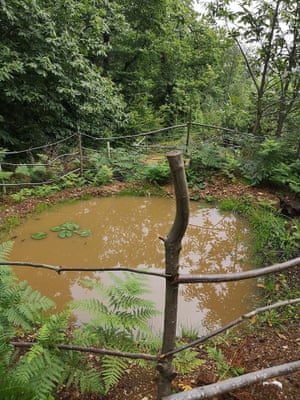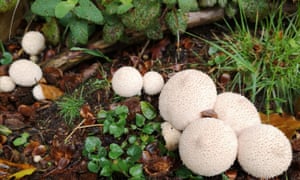Tamara and Steve Davey cannot help but grin at the suggestion they are “miniature rewilders”. Standing proudly in the weak sunlight on the fringes of Dartmoor national park, the full-time grandmother and taxi company owner delight in their eight-acre woodland.
Robins, tits and siskins chortle in the trees. Nightjars are welcome visitors in the summer. Seven bat species have been recorded in their small plot. There’s a badger’s sett somewhere in the hillside scrub. And the couple feel at peace.
“It’s good for the soul,” says Tamara, speaking before the coronavirus lockdown. “It’s one of the best things we’ve ever done,” Steve agrees. “If we can make a difference and help what’s here, I’ll be happy.”

The Daveys are not wealthy landowners planning to rewild vast parts of the countryside. But the couple, along with thousands of small do-it-yourself woodland owners, could play a vital role in restoring parts of the UK to nature and increasing the rare forests that cover just 13% of the country.
Nearly three-quarters of the 3.19m hectares (7.88m acres) of remaining woodland in the UK is privately owned, with more than 90% of plots in England smaller than 10 hectares (about 25 acres). Standing in the Daveys’ small wood, it is hard not to get carried away by visions of what might happen if a nation of gardeners turned their hands to forestry.
“Being among it and just listening to the sounds of nature is priceless, really. And you’re expanding your knowledge. You’re learning about different things all the time,” Steve says, expressing his love for summer evenings in the forest after a day driving his taxi. “We didn’t have any formal qualifications in land management or forestry. I’ve had a keen interest in wildlife all my life but, yeah, it’s enriching.”

The couple bought their piece of land through Woodlands.co.uk, which sells all kinds of plots – from one acre to more than 20 – at about GBP10,000 an acre, from the Highlands to rural Cornwall. Many owners buy their land to help promote biodiversity and reverse the effects of poor woodland management. The Daveys are no different.
Six years before they purchased their plot in 2018, the woodland was clear-felled and replaced with more than 2,000 non-native Sitka spruce, which are commonly grown in commercial plantations in the UK and are poor for biodiversity. Tamara and Steve have begun the daunting task of replacing the fast-growing conifer with sweet chestnuts, birches, oaks and native hedging to support wildlife, adding the occasional pool and clearing for bats and amphibians.

“In providing new habitats and new species, I think that’s achievable. The insects, the invertebrates, they’ve got to be catered for. If you haven’t got those, then the whole ecosystem is not so healthy. Having the grass areas, the ponds, they’ll create a huge amount of wildlife,” says Steve.
After the second world war, agriculture became more intensive and the widespread availability of plastic meant that less wood was needed to make furniture and tools. Many woodlands that were previously looked after were left to their own devices and now it is estimated that just over 40% of UK woodland is either unmanaged or undermanaged.
Management often mimics natural processes such as storm damage, which creates areas of wildlife-rich dead wood. Coppicing – cutting back trees to ground level on a five- to 20-year cycle – allows light to reach the forest floor. Before humans, large grazing animals such as bison would have browsed forests to maintain areas of low growth. This mix of dead wood, healthy trees, saplings and open spaces creates a rich mosaic of habitats.
“A well-managed woodland is more likely to have greater biodiversity than an unmanaged woodland. The basic principle is that allowing light in attracts all sorts of tiers of biodiversity,” says author Robert Penn, who bought a cottage enclosed by trees on the edge of the Black Mountains in Wales 17 years ago.
The 2.5-acre wood was previously owned by a couple who had little interest in woodland management and it had grown dark and unwieldy. Unlike the Daveys’ wood, Penn’s plot was mainly native trees that had been left to run wild.
He opened up his tiny woodland by coppicing and thinning out weaker trees to let in the light. Woodland flowers – which can lie dormant for decades – started to flourish and the plot is now peppered with wood anemones, stitchwort, celandine, primroses and wild garlic.

These spaces also provide sanctuary from the modern world. “The woodland is absolutely fundamental to my existence,” says Penn, who is patron of the Small Woods Association. “This morning, for instance, I was in my woodland and it was incredibly beautiful – wildflowers are just starting to come up, trees are about to bud, the wood is absolutely packed with birds. It’s splendid.”
Several wildlife trusts in the UK have reported increased interest in people wanting to buy land for tree planting, landowners wanting advice on carbon offsetting and communities starting tree-planting schemes. Aside from the wildlife benefits, small woods provide important ecosystem services such as reducing air pollution, locking carbon into the soil and temperature regulation. These benefits are worth hundreds of millions of pounds, according to analysis by the Office for National Statistics.
Penn’s one tip to fellow forest owners is to be patient, because managing woodland is a long-term project. “It was five years before I felt the wood was genuinely my own … and a decade later I’m absolutely confident I’m doing the right thing and I take immeasurable pleasure out of the whole thing.”

In Tortington, West Sussex, Julie and Tony Upson manage 4.5 acres of ancient semi-natural woodland. Hazel trees dominate but a majestic veteran yew stands proudly and the former palliative care nurse and city law firm facilities manager are trying to encourage the heather back on a former heath.
The couple adore the dormice that live in their woodland and credit their small forest with giving them a vibrant retirement where they spend lots of time together and bond with a community of other foresters.
“We do wish we’d done this earlier but we didn’t have the money,” Julie says, adding that the forest helped her cope with cancer treatment.

“It does give you the opportunity for unusual birthday presents. I bought Julie an axe one year and her friend thought it was a really bizarre present!” says Tony.
To others who might want to turn their hands to managing woodland for biodiversity, the couple have one message: “Go for it.”
“We’re not owners, we’re custodians of this bit of ground and these trees. Everything we do is not for us, it’s for future generations and for the planet,” says Tony.